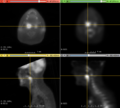Difference between revisions of "2016 Winter Project Week/Projects/Interactive4DSegmentation"
From NAMIC Wiki
Ethan.Ulrich (talk | contribs) m (added concept image) |
m (Text replacement - "http://www.slicer.org/slicerWiki/index.php/" to "https://www.slicer.org/wiki/") |
||
| Line 43: | Line 43: | ||
==Background and References== | ==Background and References== | ||
<!-- Use this space for information that may help people better understand your project, like links to papers, source code, or data --> | <!-- Use this space for information that may help people better understand your project, like links to papers, source code, or data --> | ||
| − | * [ | + | * [https://www.slicer.org/wiki/Documentation/Nightly/Extensions/mpReview Multiparametric Image Review] |
*[https://github.com/SlicerRt/Sequences Sequences] | *[https://github.com/SlicerRt/Sequences Sequences] | ||
Latest revision as of 17:37, 10 July 2017
Home < 2016 Winter Project Week < Projects < Interactive4DSegmentationKey Investigators
- Ethan Ulrich (University of Iowa)
- Andrey Fedorov, BWH
Project Description
| Objective | Approach and Plan | Progress and Next Steps |
|---|---|---|
|
|
|

